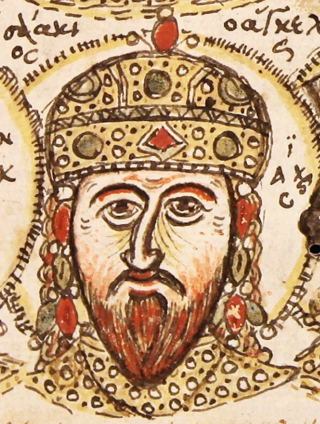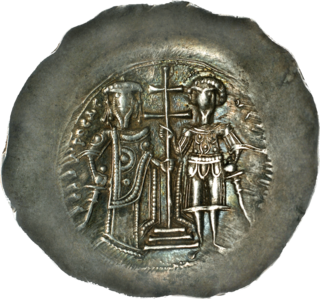
Alexios I Komnenos, Latinized as Alexius I Comnenus, was Byzantine emperor from 1081 to 1118. After usurping the throne, he was faced with a collapsing empire and constant warfare throughout his reign, Alexios was able to curb the Byzantine decline and begin the military, financial, and territorial recovery known as the Komnenian restoration. His appeals to Western Europe for help against the Seljuk Turks were the catalyst that sparked the First Crusade. Although he was not the first emperor of the Komnenian dynasty, it was during his reign that the Komnenos family came to full power and initiated a hereditary succession to the throne.

Andronikos I Komnenos, Latinized as Andronicus I Comnenus, was Byzantine emperor from 1183 to 1185. A nephew of John II Komnenos, Andronikos rose to fame in the reign of his cousin Manuel I Komnenos, during which his life was marked by political failures, adventures, scandalous romances, and rivalry with the emperor.

Isaac II Angelos or Angelus was Byzantine Emperor from 1185 to 1195, and co-Emperor with his son Alexios IV Angelos from 1203 to 1204. In a 1185 revolt against the Emperor Andronikos Komnenos, Isaac seized power and rose to the Byzantine throne, establishing the Angelos family as the new imperial dynasty.

The Empire of Trebizond or the Trapezuntine Empire was one of the three successor rump states of the Byzantine Empire that existed during the 13th through to the 15th century. The empire consisted of the Pontus, or far northeastern corner of Anatolia, and portions of southern Crimea.
Anna Dalassene was an important Byzantine noblewoman who played a significant role in the rise to power of the Komnenoi in the eleventh century. She exercised great influence over her son, the Emperor Alexios I Komnenos, who gave her the title Augusta. She also administered the empire as regent during his many absences from Constantinople on long military campaigns during the early part of his reign. As empress-mother, she exerted more influence and power than the empress-consort, Irene Doukaina, a woman whom she hated because of past intrigues with the Doukai.

The AIMA prophecy was a prophecy current during the reign of the Byzantine emperor, Manuel I Komnenos and at the same time an example of a medieval contrived acronym.

Michael I Komnenos Doukas, Latinized as Comnenus Ducas, and in modern sources often recorded as Michael I Angelos, a name he never used, was the founder and first ruler of the Despotate of Epirus from c. 1205 until his assassination in 1214/15.
Manuel Kamytzes Komnenos Doukas Angelos was a Byzantine general who was active in the late 12th century, and led an unsuccessful rebellion in 1201–02, against his cousin, Emperor Alexios III Angelos.
John Doukas, Latinized as Ducas, was the eldest son of Constantine Angelos by Theodora Komnene, the seventh child of the Byzantine Emperor Alexios I Komnenos and Irene Doukaina. John Doukas took the family name of his grandmother Irene. He served as a military commander under Manuel I Komnenos and Isaac II Angelos. Isaac II, who was Doukas's nephew, raised him to the high rank of sebastokrator. Despite his advanced age, he continued to be an active general in the 1180s and 1190s, and until shortly before his death aspired to the imperial throne. He was the progenitor of the Komnenos Doukas line, which founded the Despotate of Epirus after the Fourth Crusade.

The House of Laskaris, Latinized as Lascaris, was a Byzantine Greek noble family which rose to prominence during the late Byzantine period. The members of the family formed the ruling dynasty of the Empire of Nicaea, a Byzantine rump state that existed from the 1204 sack of Constantinople by the Fourth Crusade until the restoration of the Empire under the Palaeologan dynasty in 1261.
The House of Angelos, Latinised as Angelus, was a Byzantine Greek noble family that produced several Emperors and other prominent nobles during the middle and late Byzantine Empire. The family rose to prominence through the marriage of its founder, Constantine Angelos, with Theodora Komnene, the youngest daughter of Emperor Alexios I Komnenos. As imperial relatives, the Angeloi held various high titles and military commands under Emperor Manuel I Komnenos. In 1185, following a revolt against Andronikos I Komnenos, Isaac II Angelos rose to the throne establishing the Angeloi as the new imperial family that ruled until 1204. The period was marked by the decline and fragmentation of the Byzantine Empire, culminating in its dissolution by the Fourth Crusade in 1204 under Alexios IV Angelos.
Manuel Komnenos was the eldest son of Byzantine emperor Andronikos I Komnenos, and the progenitor of the Grand Komnenos dynasty of the Empire of Trebizond. He served his uncle, Manuel I Komnenos, as a diplomatic envoy to the Russian principalities and the Kingdom of Jerusalem, but also helped his father escape imprisonment in Constantinople. His opposition to the regency of Empress-dowager Maria of Antioch and the protosebastos Alexios Komnenos landed him in prison, but he was released in April 1182, when his father stood poised to take power in the Byzantine capital.
Maria Doukaina Komnene Petraliphaina was the wife of Theodore Komnenos Doukas, ruler of Epirus and in 1224–1230 self-proclaimed Emperor of Thessalonica. She is the earliest consort of the Epirote state known by name: the two wives of Michael I Komnenos Doukas, predecessor of her husband, were members of the Melissenos family but their first names are unknown.
Andronikos Komnenos, Latinized as Andronicus Comnenus, was a Byzantine prince of the Komnenian dynasty.
Theodora Komnene was a Byzantine noblewoman, being the fourth daughter of Emperor Alexios I Komnenos and Irene Doukaina. She married Constantine Angelos, by whom she had seven children. Byzantine emperors Alexios III Angelos and Isaac II Angelos were her grandsons, thereby making her an ancestor of the Angelos dynasty.

John Komnenos was a Byzantine aristocrat and military leader. The younger brother of Emperor Isaac I Komnenos, he served as Domestic of the Schools during Isaac's brief reign (1057–59). When Isaac I abdicated, Constantine X Doukas became emperor and John withdrew from public life until his death in 1067. Through his son Alexios I Komnenos, who became emperor in 1081, he was the progenitor of the Komnenian dynasty that ruled the Byzantine Empire from 1081 until 1185, and the Empire of Trebizond from 1204 until 1461.
Andronikos Angelos Doukas was a Byzantine aristocrat related to the ruling Komnenos dynasty. During the reign of his cousin, Manuel I Komnenos, he served without success as a military commander against the Seljuk Turks, and as envoy to the Kingdom of Jerusalem. Following Manuel's death, in 1182, he was sent to stop the rebellion of Andronikos I Komnenos but was defeated and eventually defected to him. Shortly after, he led a failed conspiracy of leading aristocrats against Andronikos I. When it was discovered, Andronikos and his sons fled the Empire, ending up in Acre, where he died. He was the father of emperors Isaac II Angelos and Alexios III Angelos.
Constantine Angelos was a Byzantine aristocrat who married into the Komnenian dynasty and served as a military commander under Manuel I Komnenos, serving in the western and northern Balkans and as an admiral against the Normans. He was the founder of the Angelos dynasty, which went on to rule the Byzantine Empire in 1185–1204 and found and rule the Despotate of Epirus (1205–1318) and the Empire of Thessalonica (1224–1242/46).

Kontostephanos, feminine form Kontostephanina (Κοντοστεφανίνα), was the name of an aristocratic Byzantine Greek family active in the 10th–15th centuries, which enjoyed great prominence in the 12th century through its intermarriage with the Komnenian dynasty.
Constantine Komnenos Angelos was a Byzantine aristocrat and military commander, and the older brother of the emperors Isaac II Angelos and Alexios III Angelos. He was blinded by the usurper Andronikos I Komnenos, and raised to sebastokrator by his brother Isaac upon the latter's accession to the throne in 1185.








